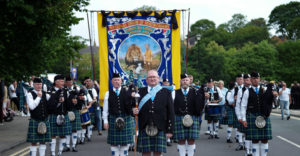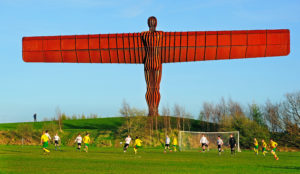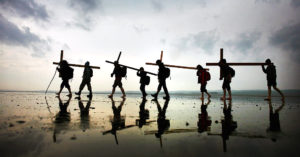Just as Brooklyn is to Manhattan and Pest is to Buda, the town of Gateshead has long been in the shadow of its grander neighbour across the water. Dr Samuel Johnson, who visited in the eighteenth century, thought the town comprised little more than “a dirty lane leading to Newcastle”, and many still see “the ‘Heed” as little more than a suburb of “the Toon”. JB Priestley’s sniffy comment in 1934 is typical of tourists from the more southerly parts of England: writing of Gateshead in English Journey, he observed that, “no true civilisation could have produced such a town”. It appeared, to him, to have been designed “by an enemy of the human race”. “Insects,” he added, “can do better than this.”
Gateshead may still be overshadowed, but its greatest monument has become legendary. Anthony Gormley’s Angel of the North celebrates its 25th birthday this month: a worthy occasion to remind ourselves that the town in which it stands is a microcosm of North East England, and its guardian angel represents both the past and the future of a region that continues to evolve.
If industrial Gateshead appeared to visitors like Priestley as a squalid anthill, then this was the consequence of the modernity that that had come to Tyneside as early as the seventeenth century. Nearby Whickham has a good claim to be Britain’s first truly industrial society; by 1700, over 75% of the residents worked in mines and factories. The pride of neighbouring Winlaton was Sir Ambrose Crowley’s ironworks, reputedly the greatest manufactory of ironware anywhere in Europe, which churned out pots and pans, shackles for the slave trade, and the nails that held together the wooden walls of the Royal Navy. To house the expanding workforce, a sort of model village sprang up, which prefigured the terraced streets that went on to so characterise the North of England.
Places like Whickham were built on the mountain of coal that lay beneath the rolling landscape of northern County Durham. By 1911, fully one third of the county’s working age population were mining it, sending their output up to the Tyne for export, via the mighty Dunston Staiths in Gateshead. The ACDC frontman Brian Johnson grew up in Dunston and recalls that the pits and steelworks would “declare a truce on Mondays” so washing could be hung out without getting filthy. The quote from Virgil’s Aeneid that appeared on Gateshead’s civic arms — Caput Inter Nubila Condit (“Its head is in the clouds”) — was a nod to the smoke that usually wreathed the town.
Gateshead, then, was a firmly working-class place, a sort of proletarian backstage to the grandeur of Georgian Newcastle, and a place where some of the richest, most mellifluous Geordie is spoken by the natives. Brian Johnson himself has an accent as thick as a submarine window, and the folk culture of Northumbria is replete with references to the children of Gateshead. It is the home of the fictional Cushie Butterfield, the star of a well-known Geordie drinking song. (“She’s a big lass, and a bonnie lass, and she likes her beor.”) It is also the site of that riotous bacchanal of 1862, the famous Blaydon Races — which is the subject of Tyneside’s national anthem — as well as the once-mighty Federation Brewery, a huge structure by the Tyne that looked like a Soviet power plant, and whose output was served in the Palace of Westminster. The town’s traditions run as deep as the coal seams under County Durham.
But Gateshead was also a site of modernism. Thomas Wright, the first astronomer to speculate that faint nebulae were distant galaxies, was educated there. In the nineteenth century, the lightbulb inventor Sir Joseph Swan lived in Low Fell, the town’s grandest suburb, where his house, Underhill, was the first in the world to be illuminated by electricity. And in 1984, a housebound Gateshead pensioner called Jane Snowball became the world’s first online shopper when she took part in an innovative council scheme to place an order from her local Tesco using her TV’s remote control. She bought cornflakes, eggs, and margarine.
And beneath where the Angel of the North now spreads its wings lies a site of huge significance for Britain’s modern industrial history. It was in the Team Valley in 1934 — amid a depression that had cratered demand for coal and ships, and therefore crippled the North East’s economy — that the national government decided to build Europe’s first ever industrial estate. Its aim was to create “facilities required by industrialists engaged in starting fresh enterprises” — of the type that were then booming in the South. The locale had been rural until a colliery opened there in 1842 — one of many operated by our new King’s stupendously wealthy ancestors, the Bowes family. But by the Thirties, 57% of Gateshead’s population was out of work — so, in the words of the commissioner appointed to help Britain’s “special areas” by the surprisingly forward-thinking Chancellor Neville Chamberlain, “novel and unorthodox” measures were required.
Over £2million of government funding was awarded to transform the boggy, 700-acre site. The designs were produced by 29-year-old William Holford — a key figure in twentieth-century urban planning, who worked on the masterplans for Durban and Canberra. The industrial estate enabled Gateshead to diversify. After it was opened by King George VI in 1939, the first tenants were very different to the usual heavy industries, with haulage contractors, coachbuilders, and clothing factories proliferating. This was Tyneside’s answer to the Golden Mile in West London — with its grand, art deco Hoover and Firestone factories — and by the Sixties, more than 16,000 people worked at the Team Valley Trading Estate. And it’s still thriving, with more than 20,000 employed there in firms as diverse as Express Engineering and Primula Cheese.
Driven by a similar sense of reinvention, by the Nineties Gateshead Council started to conceive of a new landmark that would welcome travellers to Tyneside, acting as a “millennial image that would be a marker and guardian for our town”. When Anthony Gormley was first approached by the council, he was unconvinced, dismissive as he was of “roundabout art”. But then he saw a photo of the mound where the old pithead baths had been; it reminded him of the tumuli at Wayland’s Smithy, the evocative bronze age barrow grave in Oxfordshire. What Gormley then created — a 20-metre-tall steel colossus, based on a cast of his own body — has a similar ineffability: the North’s response to the great priapic giant of the South at Cerne Abbas in Dorset.
The Angel’s site, at the southern approaches to Gateshead Fell, presents a 360 degree sweep of Northumbrian history. To the North lie the heights of Sheriff Hill, an eleventh-century battlefield and the spot where the burghers of Newcastle would turn out to meet the justices before they crossed the Tyne. Slightly to the West are the ancient Anglo-Saxon settlements of Ravensworth and Kibblesworth, and the valley of the Derwent River, one of the great crucibles of the industrial revolution. In the South is Birtley, once the site of the sprawling munitions plant of “Elisabethville”, which was home to 6,000 refugees from war-torn Flanders during the First World War, when it was run as a Belgian colony by the government in Brussels. To the South-East lies the Sixties new town of Washington, and its vast Nissan factory, which churns out more cars in a year than the whole of Italy. Finally, lying deep beneath the site is a former colliery, where miners toiled (and frequently died) for 200 years. Few locations can evoke the richness of Tyneside’s history, and to stand here on a bright and windy day, while the diggers and cranes puff and pant nearby to widen the A1, reminds you that this place is always on the move.
“People are always asking, why an angel?” Gormley once said. It isn’t a specifically Tyneside symbol. The so-called “Dirty Angel” on a column in Newcastle’s Haymarket is actually a rather Wagnerian depiction of Nike, the Greek goddess of victory, brandishing a sword and laurel wreath and raised in memory of the Northumbrians who fell in the Boer War. Gateshead itself — home of the formidable “Gateshead Gurkhas”, spearpoint of the British Army in the Second World War — has on its cenotaph a stern depiction of “manhood in the attitude of defence” above the Latin proverb MORS JANUA VITAE: “Death is the Gate to Life”. Despite its 208-tonne weathered Corten steel bulk, and 177ft wingspan, the Angel of the North is more benign and irenic — its wings subtly angled forward by 3.5 degrees to create a sense of embrace.
Made of the same quarter inch-thick plate that was the staple of Tyneside shipyards, the sculpture was inspired by a conversation between Gormley and a local councillor, Pat Conaty, who had migrated from County Cavan to Gateshead in the Fifties — just as so many belonging to the Irish Diaspora before him had come to the coalfields and steelworks of North-East England. “What we need Mr Gormley,” said Cllr Conaty as they walked up the site, “is one of your angels.” From the late Eighties, Gormley had played with angelic imagery in a sculptural series called The Case for an Angel, and this suggestion captured his imagination — and may also have appealed to his own Irish Catholic background (his parents chose his initials to spell out the old Jesuit motto AMDG).
The result was a masterpiece of monumental sculpture: a work of public art utterly different from the reactionary and totalitarian monumentalism that Gormley had wanted so much to avoid. And it soon inspired genuine local affection — so much so that before Newcastle United’s appearance in the 1998 FA Cup Final, the Angel was vested in a huge black and white shirt bearing the name of local hero Alan Shearer. “I was very moved,” said Gormley later. “That was a baptism.”
What does the Angel represent, 25 years after its birth? It has certainly become a cynosure for Gateshead itself, even replacing the goat’s head on the local football club’s crest, and whenever I drive past it on the A1, I’m always struck by its enduring power and dignity. The word angel comes from the Greek angelos, itself a translation of a Hebrew word meaning “messenger”, and has been used in that sense, both secularly and spiritually, since its first manifestation in Old English. Can this Angel bring a hopeful message to a region of England that has not enjoyed a happy transition from the industrial to the information age?
In numerous interviews, Gormley has mused on what this great structure had meant to him and the people who built it, how rooted it is — literally, with 20-metre-deep foundations to stop the North winds blowing it over — and how it transcended individual lives. But when asked the simplest question, why he chose an angel, Gormley replied simply: “The only response I can give is that no-one has ever seen one and we need to keep imagining them.” Given everything that has gone before the Angel, and the enduring hardship of its hometown, we need to keep reimagining what places like Gateshead — and the wider North East — could be like, too.
Disclaimer
Some of the posts we share are controversial and we do not necessarily agree with them in the whole extend. Sometimes we agree with the content or part of it but we do not agree with the narration or language. Nevertheless we find them somehow interesting, valuable and/or informative or we share them, because we strongly believe in freedom of speech, free press and journalism. We strongly encourage you to have a critical approach to all the content, do your own research and analysis to build your own opinion.
We would be glad to have your feedback.
Source: UnHerd Read the original article here: https://unherd.com/





